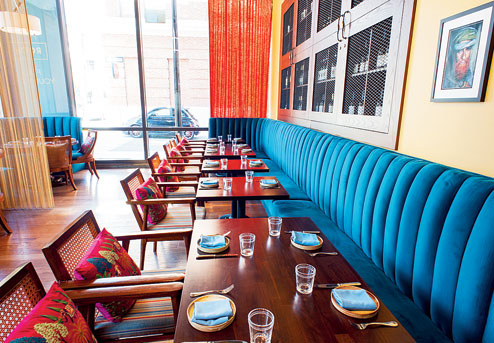
Rooh [which means spirit in Urdu] is feverishly busy on a Thursday evening. Luckily, we already have a table reserved. We walk past gold mesh curtains and teal couches and find our seats, facing a wall with the mural of a lady with a lotus in her hand, straight out of the Mughal era. But there’s a twist. She is American.
That’s when the menu falls into place. Beetroot Murabba with Masala Hazelnut. Green Peas Kulcha with Goat Cheese. Achari Wild Salmon Salad. This is progressive Indian cuisine in San Francisco (or as a layperson would say, desi dining turned on its head).

Partner-cum-chef of this 100-seater restaurant and cocktail bar in downtown SF (333 Brannan Street, SoMa) is a Bengali named Sujan Sarkar, born and brought up in Kalyani. If the name sounds familiar, you probably know him as the chef and partner at Ek Bar, the artisanal bar serving seasonal cocktails and modern Indian small plates in Delhi.
He is also culinary adviser to Olive Bar & Kitchen, Delhi, having made standout changes to the menu after chief AD Singh invited him to return to India from London, where Sujan was with Automat, Michelin-star Galvin at Windows (Hilton Park Lane) and celebrity hot spot Almada among others.
Rooh opened doors in February and is already being talked about in food circles. The owners of the place are Vikram and Anu Bhambri of the Good Times Restaurant Group that owns restaurants like Fork You Too in Delhi. The splashy interiors of Rooh lend a busy vibe and the cocktail bar is Ayurvedic, with drinks like Chai Punch (Monkey Shoulder + grapefruit shrub + Assam tea + spice blend) and Pink City (plantation rum + guava + Indian chilli + Rooh masala).
Tempting as it sounds, we skip the drinks with the jet lag starting to kick in on Day One of our Visit California tour. Sujan has prepared an elaborate tasting menu [diners can either choose a la carte or a 11-course tasting menu] and we are eager to know more. “It took us almost 11 months to build this place from scratch. The design, the food, everything,” said Sujan, as he joined t2 for dinner. We last met him in Calcutta at The Market Place, a curated event at Vedic Village in August, 2016.
TASTING MENU @ ROOH

How did Rooh happen?
I’m trained in modern European and French cuisine and used to run two of the biggest standalones in London, called Automat [now closed] and Almada. I started doing modern Indian cuisine in 2011. Then I met AD [Singh] and he asked me to come to India. I agreed to give it a shot because I wanted to do something with Indian food and that wasn’t happening in London.

In India, I changed the entire menu at Olive, Delhi. Then I got an opportunity to open Tresind in Dubai through Rahul Bhambri [Vikram’s brother] but then there was a fallout with investors. That’s when AD and I opened Ek Bar together and got great reviews. At the same time I was doing The Tasting Lab [featuring his most creative dishes at Olive, Delhi]. After a few years, I figured I was more comfortable cooking for a western audience. This project came in, and I said yes. At first, they wanted to open in Palo Alto, but I always wanted to start my first restaurant downtown.
Tell us about the concept of Rooh…
The menu at Rooh offers progressive Indian dishes, a combination of Northern California ingredients, traditional Indian flavours and and modern cooking techniques. The idea is to mix east and west. But there are some things you can’t change — if I do foam on butter chicken, it won’t be butter chicken.
There is an urban India, a modern India. That should reflect in our food. I want people to know. Which is why the tasting menu at Rooh, made up of 11 dishes including the canapes, is $80. People come and laugh. A tasting menu at other restaurants is $300… of course, they’ve got 20 courses; I can give 20 courses too. But for Indian food you have to go step by step.
According to you, what is the new definition of Indian food? There’s Gaggan Anand and Manish Mehrotra also doing progressive Indian…
I think my food is progressive in different ways because I use more ingredients. Gaggan is in Thailand, does tasting menus, different format. Of course, I do that kind of thing — yesterday I was in New Mexico manning a 120-people wine dinner. But in a mainstream restaurant where you do 150-200 covers, you can’t follow that format… someday when I open my 40-50 cover restaurant, I’ll do it.
In London, Indian food means Chicken Tikka Masala. What does it mean here?
We have a lot of chaat houses here so people still think of that as Indian food.
We noticed a couple of south Indian dishes on the menu. How easy is it to adapt that into something modern?
We do a few things here — like the Asparagus a la Plancha. The asparagus goes really well with podi masala, it’s subtle, not too spicy, and we are serving it with cauliflower mousse. That’s exciting. That’s innovation. That’s taking the cuisine forward.
Having grown up in Kalyani, who do you know from Calcutta?
Sudip (Mullick from Balaram Mullick & Radharaman Mullick) is a dear friend. We are from the same college. And, Joy (Banerjee of Bohemian), I know him very well.
What next for Sujan?
I’m opening the “first” Indian gastrobar in Manhattan, New York, in September-October. It’s a big space, very exciting, open only in the evening. It will serve Indian tapas with Indian-inspired cocktails and a huge selection of wines.
Text: Karo Christine Kumar

